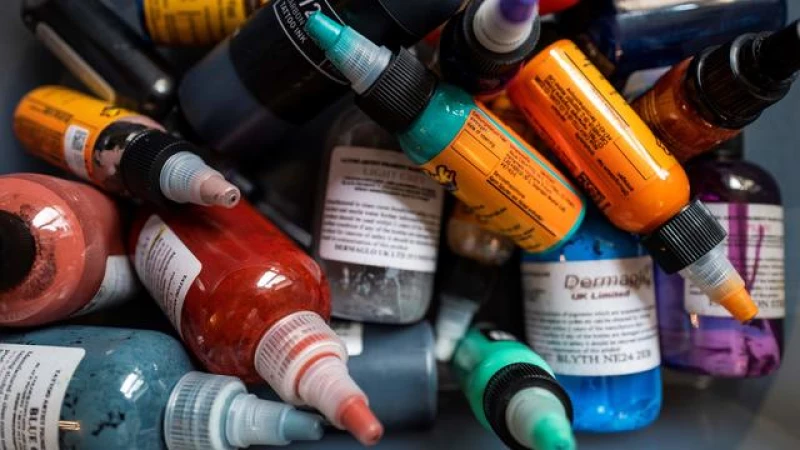John Swierk is an assistant professor of chemistry at Binghamton University, State University of New York.
Tattoos are an incredibly common form of permanent self-expression that date back thousands of years. Most tattoo artists follow strict health and sanitation regulations, so you might assume that tattoo inks are carefully regulated, too.
But as work done by my team of chemistry researchers suggests, up to 90% of tattoo inks in the U.S. might be mislabeled. This isn't just a case of a missing pigment or a minor discrepancy. These inks contained potentially concerning additives that weren't listed on the packaging.
What's in an ink?
All inks are made up of one or more pigments, which are molecules that give tattoos their color, and some kind of carrier for that pigment. Before the 20th century, pigments used in tattooing included ash, charcoal, minerals or other natural materials. Around the middle of the 20th century, though, tattoo artists started making their own inks using synthetic pigments and dyes.
Today, nearly all pigments used in tattoos are made of synthetic molecules that allow for bright colors – with the exception of white and black pigments.
In recent years, the landscape of tattoo ink manufacturing has evolved significantly. What was once a practice of individual artists creating their own inks has transformed into large companies producing and distributing inks to tattoo artists. To investigate the contents of these inks, our team conducted a study where we examined a total of 54 tattoo inks available in the U.S. market.
Hidden Ingredients
Our analysis revealed that more than half of the tattoo inks we studied contained undisclosed polyethylene glycol (PEG). While PEG is commonly found in various medical products like laxatives, it has the potential to trigger allergic reactions. Furthermore, research indicates that prolonged exposure to PEG through tattooing could potentially result in kidney failure.
Additionally, we identified propylene glycol in 15 of the inks, despite it not being listed as an ingredient in any of them. Although propylene glycol is generally considered safe and is structurally similar to glycerin, which is used to thicken the ink, some individuals may have severe allergic reactions to it. In fact, propylene glycol was named the American Contact Dermatitis Society's Allergen of the Year in 2018, highlighting its potential for causing skin rashes, itching, and blistering.
Furthermore, our investigation uncovered unlisted ingredients in several tattoo inks that are commonly found in cosmetics but have not been thoroughly examined in the context of tattooing. These include BHT, dodecane, and 2-phenoxyethanol. While 2-phenoxyethanol can serve as a preservative in low concentrations, the Food and Drug Administration has cautioned that it may be transferred to infants through breastfeeding, potentially causing vomiting and dehydration in babies.
Out of the 54 inks analyzed, 29 were found to report the correct pigments, while the remaining did not report or reported incorrect pigments. This issue is well-known in the world of tattoo inks that manufacturers have yet to address.
Pigment concerns
Research has indicated that carbon black, the main black pigment used in tattoos, could be contaminated with some of the same cancer-causing compounds present in car exhaust and cigarette smoke.
Several red, yellow, and orange pigments are azo pigments, containing two linked nitrogen atoms. While these pigments provide vibrant colors, they may eventually degrade into carcinogens over time.
Regulations in Europe prohibit the use of copper-containing pigment blue 15 and pigment green 7, which were identified as the sole blue and green pigments in the inks examined in my study. The EU banned these pigments due to concerns that their presence in hair dyes could lead to bladder cancer, although this potential link has not yet been explored in the context of tattoos.
A new focus on regulation
The FDA is starting to show more interest in the composition of tattoo inks. In 2022, Congress approved the Modernization of Cosmetics Regulation Act, or MoCRA, granting the FDA expanded powers to regulate tattoo inks.
Although the FDA is still determining how to enforce MoCRA, the legislation will mandate accurate labeling of ingredients and enhance the FDA's ability to recall inks. Historically, tattoo inks have been rarely recalled, and only on a voluntary basis, due to bacterial contamination.
For tattoo clients and artists, the safety of tattoos remains a topic of debate. While some research suggests potential risks such as infection and allergic reactions, the lack of a clear consensus adds to the uncertainty. Additionally, factors like size, color, and placement on the body contribute to the complexity of assessing tattoo safety.
Studies like the one conducted by a research lab shed light on the composition of tattoo ink, aiding in the understanding of possible long-term effects like allergic reactions. This knowledge is crucial for healthcare professionals to recognize and address specific health issues in individuals with tattoos.
Known health risks associated with tattoos often stem from inexperienced artists who neglect proper sanitation practices. To mitigate these risks, individuals interested in getting a tattoo are advised to choose a skilled artist who prioritizes hygiene and provides thorough aftercare instructions.
This article is republished from The Conversation under a Creative Commons license.







